coolant Peugeot Bipper Dag 2009 Owner's Manual
[x] Cancel search | Manufacturer: PEUGEOT, Model Year: 2009, Model line: Bipper Dag, Model: Peugeot Bipper Dag 2009Pages: 154, PDF Size: 4.07 MB
Page 12 of 154
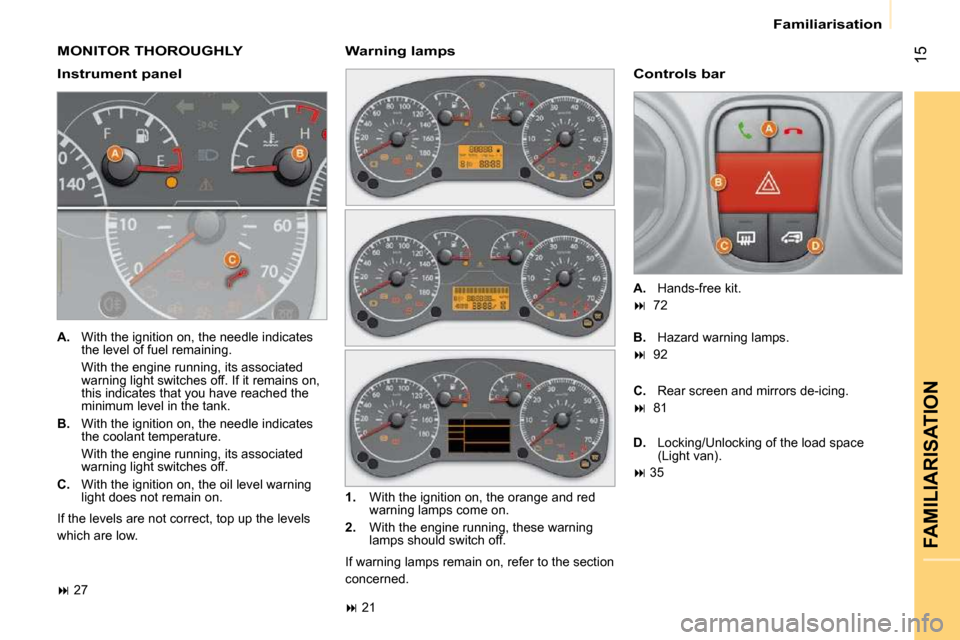
15
FAMILIARISATION
Familiarisation
MONITOR THOROUGHLY
Instrument panel Controls bar
A. With the ignition on, the needle indicates
the level of fuel remaining.
With the engine running, its associated warning light switches off. If it remains on,
this indicates that you have reached the
minimum level in the tank.
B. With the ignition on, the needle indicates
the coolant temperature.
With the engine running, its associated warning light switches off.
C. With the ignition on, the oil level warning
light does not remain on.
If the levels are not correct, top up the levels
which are low.
A. Hands-free kit.
� 72
1. With the ignition on, the orange and red
warning lamps come on.
2. With the engine running, these warning
lamps should switch off.
If warning lamps remain on, refer to the section
concerned.
Warning lamps
� 21
� 27
B. Hazard warning lamps.
� 92
C. Rear screen and mirrors de-icing.
� 81
D. Locking/Unlocking of the load space
(Light van).
� 35
Page 16 of 154
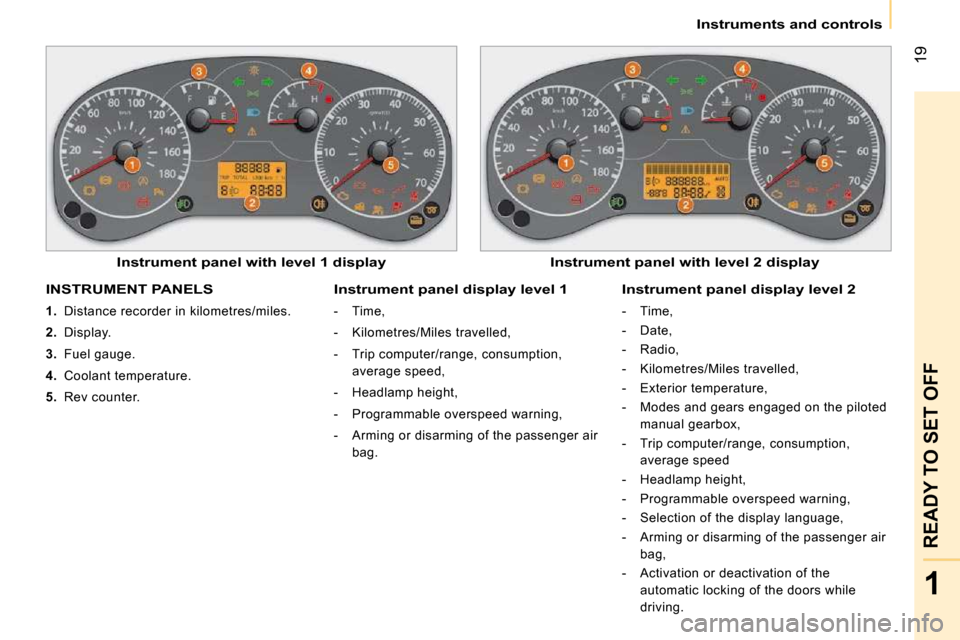
19
1
READY TO SET OFF
Instruments and controls
INSTRUMENT PANELS
1. Distance recorder in kilometres/miles.
2. Display.
3. Fuel gauge.
4. Coolant temperature.
5. Rev counter.
Instrument panel with level 1 display Instrument panel with level 2 display
Instrument panel display level 1
- Time,
- Kilometres/Miles travelled,
- Trip computer/range, consumption,
average speed,
- Headlamp height,
- Programmable overspeed warning,
- Arming or disarming of the passenger air bag.
Instrument panel display level 2
- Time,
- Date,
- Radio,
- Kilometres/Miles travelled,
- Exterior temperature,
- Modes and gears engaged on the piloted manual gearbox,
- Trip computer/range, consumption, average speed
- Headlamp height,
- Programmable overspeed warning,
- Selection of the display language,
- Arming or disarming of the passenger air bag,
- Activation or deactivation of the automatic locking of the doors while
driving.
Page 18 of 154

21
1
READY TO SET OFF
Instruments and controls
WARNING LAMPS
Each time the engine is started: a series of warning lamps comes on applying a self-checking test. Th ey switch off almost immediately.
When the engine is running: the warning lamp become s a warning sign if it remains on continuously or flashes. This initial warning may be
accompanied by an audible signal and a message on t he display. "Do not ignore these warnings."
Warning lamp
is indicates Solution - action
Service on temporarily. minor faults. Consult a PEUGEOT
dealer.
continuously on,
accompanied by a
message on the display. major faults.
Make a note of the warning message and contact
a PEUGEOT dealer.
Handbrake
Brake fluid level on.
that the handbrake is applied or
has not been released correctly. Releasing the handbrake switches off the
warning lamp.
on. that the fluid level is too
low. Top up with a fluid recommended by a
PEUGEOT dealer.
continuously on, even
though the level is correct.
Stop immediately, park, switch off the
ignition and contact a PEUGEOT dealer.
Low engine oil level on.
that the level of oil in the
engine is too low. Check the engine oil level and contact a
PEUGEOT dealer.
continuously on, even
though the level is correct.
Stop immediately, park, switch off the
ignition and contact a PEUGEOT dealer.
Coolant temperature on with the needle in
the red zone.
an abnormal increase. Park and switch off the ignition, allow the circui
t
to cool. Visually check the level.
on H in the red zone. an abnormal increase in
the coolant temperature. Refer to the "Levels" section of chapter 7.
Consult a PEUGEOT dealer.
Page 25 of 154
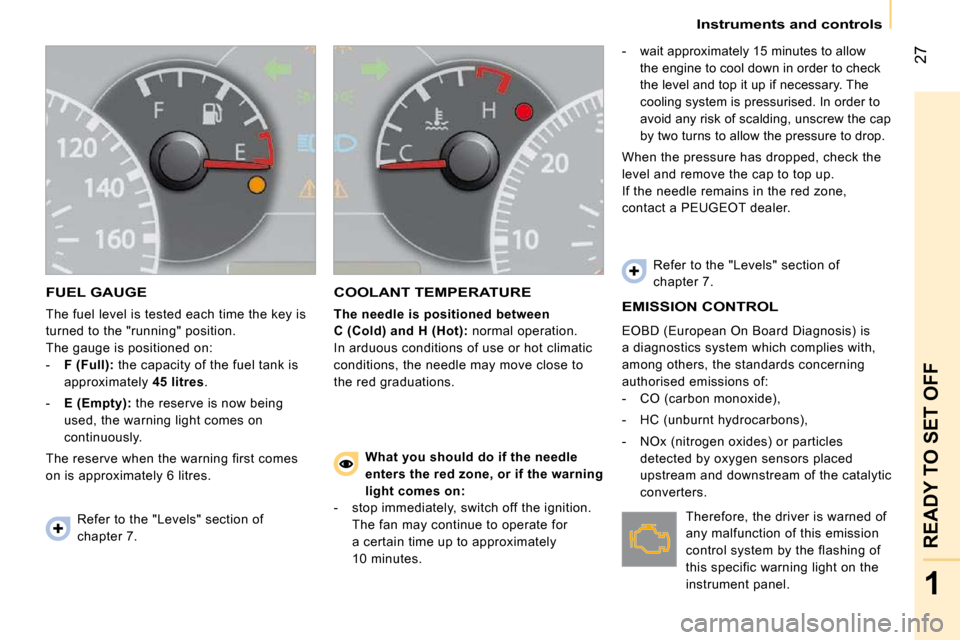
27
1
READY TO SET OFF
Instruments and controls
FUEL GAUGE
The fuel level is tested each time the key is
turned to the "running" position.
The gauge is positioned on:
- F (Full): the capacity of the fuel tank is
approximately 45 litres .
- E (Empty): the reserve is now being
used, the warning light comes on
continuously.
The reserve when the warning first comes
on is approximately 6 litres.
COOLANT TEMPERATURE
The needle is positioned between
C (Cold) and H (Hot): normal operation.
In arduous conditions of use or hot climatic
conditions, the needle may move close to
the red graduations. - wait approximately 15 minutes to allow
the engine to cool down in order to check
the level and top it up if necessary. The
cooling system is pressurised. In order to
avoid any risk of scalding, unscrew the cap
by two turns to allow the pressure to drop.
When the pressure has dropped, check the
level and remove the cap to top up.
If the needle remains in the red zone,
contact a PEUGEOT dealer . EMISSION CONTROL
EOBD (European On Board Diagnosis) is
a diagnostics system which complies with,
among others, the standards concerning
authorised emissions of:
- CO (carbon monoxide),
- HC (unburnt hydrocarbons),
- NOx (nitrogen oxides) or particles detected by oxygen sensors placed
upstream and downstream of the catalytic
converters.
Refer to the "Levels" section of
chapter 7. Refer to the "Levels" section of
chapter 7.
Therefore, the driver is warned of
any malfunction of this emission
control system by the flashing of
this specific warning light on the
instrument panel.
What you should do if the needle
enters the red zone, or if the warning
light comes on:
- stop immediately, switch off the ignition. The fan may continue to operate for
a certain time up to approximately
10 minutes.
Page 123 of 154
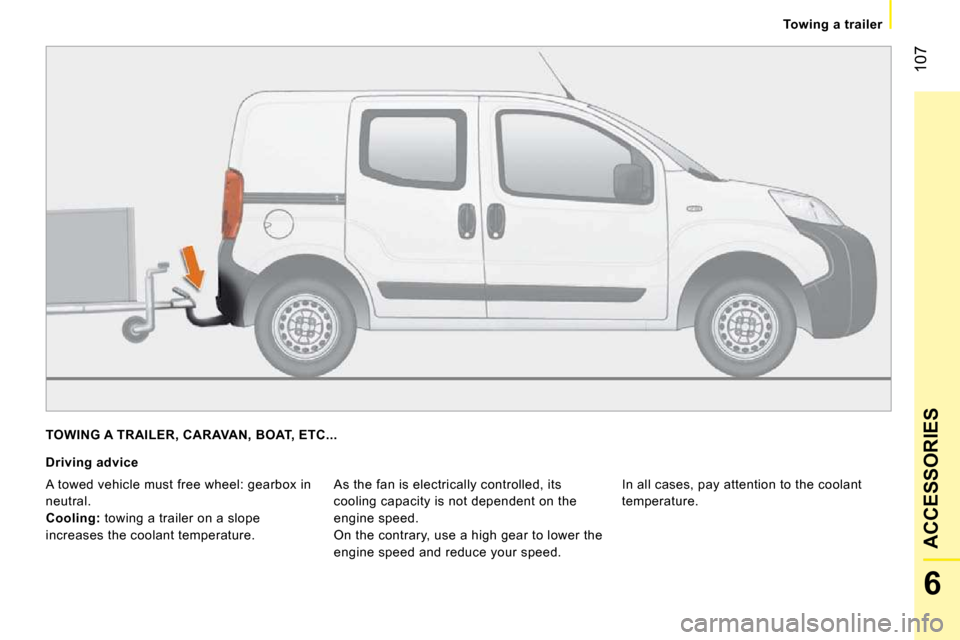
107
6
ACCESSORIES
Towing a trailer
TOWING A TRAILER, CARAVAN, BOAT, ETC...
Driving advice
As the fan is electrically controlled, its
cooling capacity is not dependent on the
engine speed.
On the contrary, use a high gear to lower the
engine speed and reduce your speed. In all cases, pay attention to the coolant
temperature.
A towed vehicle must free wheel: gearbox in
neutral.
Cooling: towing a trailer on a slope
increases the coolant temperature.
Page 124 of 154
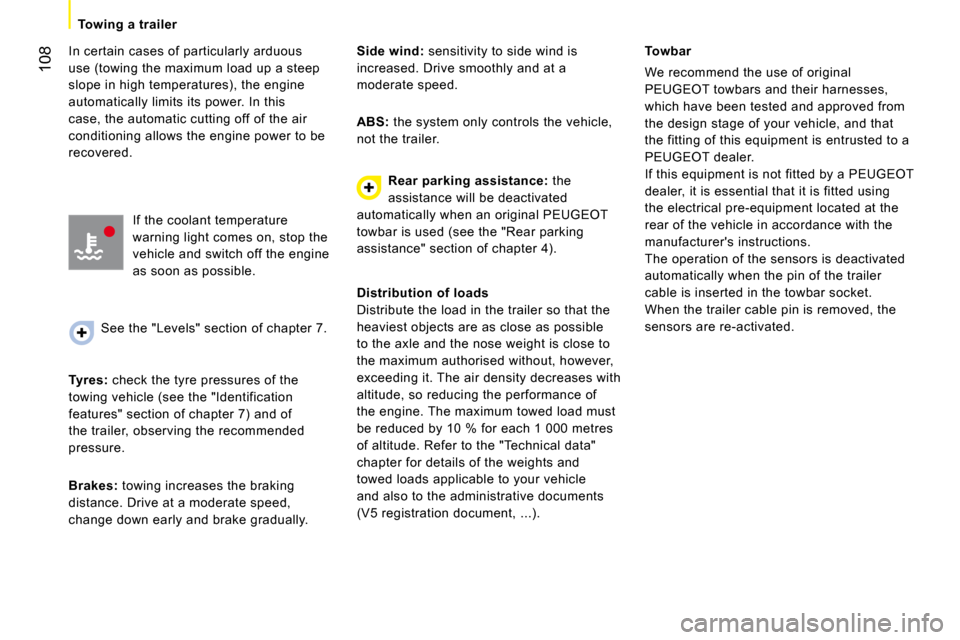
108
Towing a trailer
In certain cases of particularly arduous
use (towing the maximum load up a steep
slope in high temperatures), the engine
automatically limits its power. In this
case, the automatic cutting off of the air
conditioning allows the engine power to be
recovered.
If the coolant temperature
warning light comes on, stop the
vehicle and switch off the engine
as soon as possible.
See the "Levels" section of chapter 7.
Tyres: check the tyre pressures of the
towing vehicle (see the "Identification
features" section of chapter 7) and of
the trailer, observing the recommended
pressure.
Brakes: towing increases the braking
distance. Drive at a moderate speed,
change down early and brake gradually.
Side wind: sensitivity to side wind is
increased. Drive smoothly and at a
moderate speed.
ABS: the system only controls the vehicle,
not the trailer.
Rear parking assistance: the
assistance will be deactivated
automatically when an original PEUGEOT
towbar is used (see the "Rear parking
assistance" section of chapter 4).
Towbar
We recommend the use of original
PEUGEOT towbars and their harnesses,
which have been tested and approved from
the design stage of your vehicle, and that
the fitting of this equipment is entrusted to a
PEUGEOT dealer .
If this equipment is not fitted by a PEUGEOT
dealer , it is essential that it is fitted using
the electrical pre-equipment located at the
rear of the vehicle in accordance with the
manufacturer's instructions.
The operation of the sensors is deactivated
automatically when the pin of the trailer
cable is inserted in the towbar socket.
When the trailer cable pin is removed, the
sensors are re-activated.
Distribution of loads
Distribute the load in the trailer so that the
heaviest objects are as close as possible
to the axle and the nose weight is close to
the maximum authorised without, however,
exceeding it. The air density decreases with
altitude, so reducing the performance of
the engine. The maximum towed load must
be reduced by 10 % for each 1 000 metres
of altitude. Refer to the "Technical data"
chapter for details of the weights and
towed loads applicable to your vehicle
and also to the administrative documents
(V5 registration document, ...).
Page 150 of 154
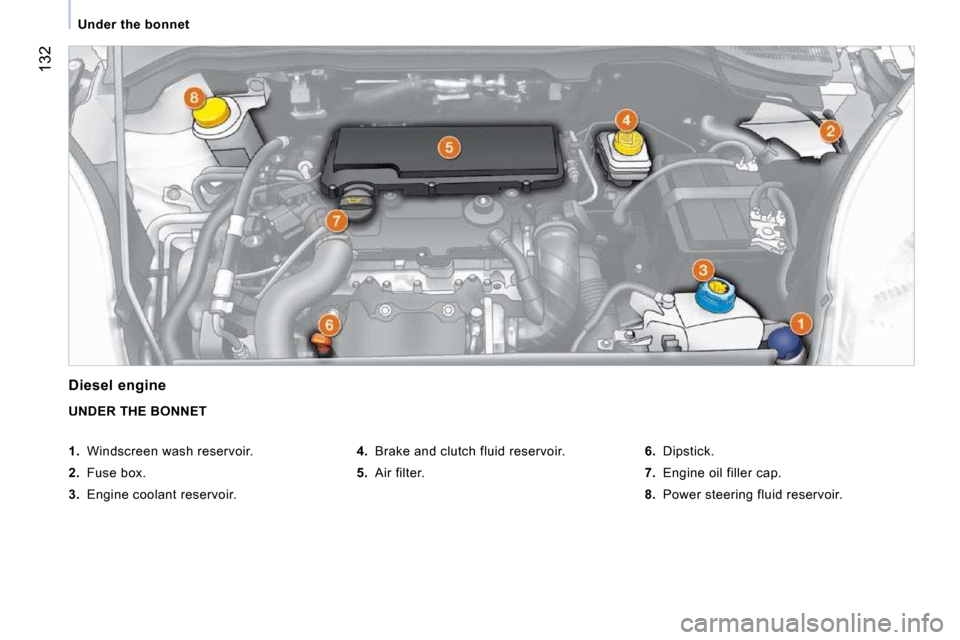
132
Under the bonnet
Diesel engine
UNDER THE BONNET
4. Brake and clutch fluid reservoir.
5. Air filter.
6. Dipstick.
7. Engine oil filler cap.
8. Power steering fluid reservoir.
1. Windscreen wash reservoir.
2. Fuse box.
3. Engine coolant reservoir.
Page 151 of 154
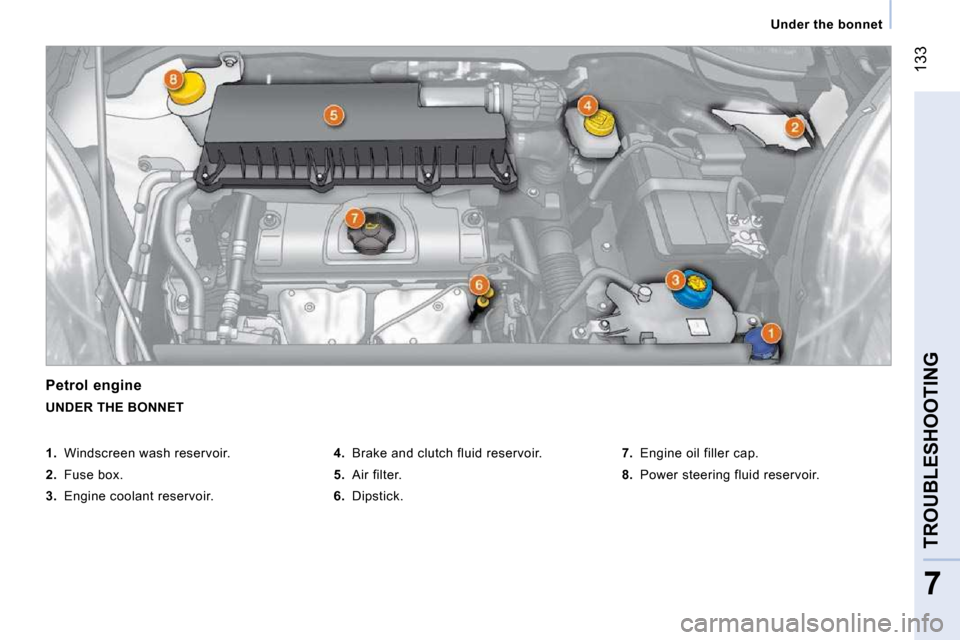
133
7
TROUBLESHOOTING
Under the bonnet
Petrol engine
UNDER THE BONNET
4. Brake and clutch fluid reservoir.
5. Air filter.
6. Dipstick.
7. Engine oil filler cap.
8. Power steering fluid reservoir.
1. Windscreen wash reservoir.
2. Fuse box.
3. Engine coolant reservoir.
Page 153 of 154

135
7
TROUBLESHOOTING
Levels
Cooling system
Only use the fluid recommended by the
manufacturer. Otherwise, you risk seriously
damaging your engine. When the engine
is warm, the temperature of the coolant is
controlled by the engine fan. As this fan can
operate with the ignition key removed and
because the cooling system is pressurised,
wait for at least one hour after the engine
has stopped before carrying out any work. Topping up
The level must be between the MIN and
MAX marks on the expansion bottle.
If more than 1 litre of fluid is required to top
up the level, have the system checked by a
PEUGEOT dealer.
Power steering fluid level
The vehicle must be parked on level ground with
the engine cold. Unscrew the cap integrated with
the gauge and check the level which must be
between the MIN and MAX marks.
Windscreen wash level
For best quality cleaning and for your safety,
we would advise that you use products of
the PEUGEOT Universal range.
Capacity of the reservoir: approximately
5.5 litres.
Used oil
Avoid prolonged contact of used oil with the
skin.
Brake fluid is harmful to health and very
corrosive.
Do not dispose of used oil, brake fluid or
coolant into drains or into the ground but
into the containers dedicated to this use at a
PEUGEOT dealership.
Slacken the cap by two turns to release the
pressure to prevent any risk of scalding.
When the pressure has dropped, remove the
cap and top up the level with coolant.
If fluid has to be added frequently, this
indicates a failure which must be checked by
a PEUGEOT dealer as soon as possible.